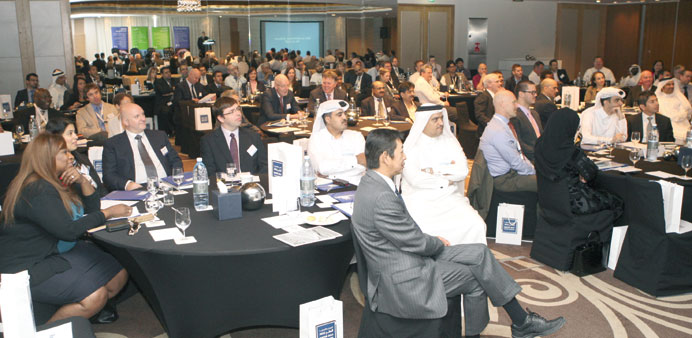Health and safety professionals from the Middle East at the IOSH conference held at W Hotel Doha in Qatar yesterday. PICTURE: Jayaram
By Joey Aguilar/Staff Reporter
Building designers in Qatar and their clients are duty bound to consider the possibility of tremors or earthquakes to happen in the future, an expert on safety, health and environment in the Middle East has said.
Speaking on the sidelines of the Institution of Occupational Safety and Health (IOSH) conference at the W Hotel Doha yesterday, Aecom director Steve Wood told Gulf Times that there has to be due consideration in designing buildings.
“In terms of future constructions, I think the clients and designers are duty bound to actually consider the possibility that one of these tremors will hit again,” he said. Wood cited the importance of putting seismic dampers on all the buildings which will be built in the future. These changes, he said, is related to the frequency of tremors this year and the proximity of Qatar to Iran and Pakistan where the recent 7.8 magnitude earthquake happened.
But for the existing structures, the director said that he does not have any clue on what terms and arrangements they have been built in the past. “Existing buildings I don’t have any idea. The future buildings I think should be considered,” he added.
At least two tremors were felt across Doha recently, prompting employees to evacuate many of the buildings in West Bay and along Airport road. Wood was not only referring to high-rise buildings but to all future structures, saying earthquakes and tremors are a new thing in Qatar and in the Middle East.
“We cannot control Mother Nature. Mother Nature is very strong and very powerful. But there needs to be some considerations about what is the potential and impact in terms of risk management we are looking at – heat related issues, the ground conditions etc,” he said. Wood also mentioned the cases in Japan, China and Mexico where designs have been taken into consideration because of the events that have happened in those locations. In his presentation, Velosi-Qatar health and safety engineer Mark Kenyon disclosed that some buildings had structural damages caused by the last tremor in Doha.
Wood said he was not aware about any damages “or whatsoever caused by the latest one.” “To my knowledge there was no structural damage, now he (Kenyon) is telling me that it is there.”
Recent reports have also revealed that two walls of an office in the new Philippine embassy building had developed cracks after the second tremor.
“If there is something about it, then there could be possibly further structural damages to the buildings (to be built),” said the director.
In his presentation, he talked about the new fire safety legislation in Qatar, specifically Law No 9, the 2012 Civil Defence amendment to Law No 12 of 1997.
He also lauded the new law. Fines and penalties against violators range from QR200,000-500,000, with imprisonment for a certain number of years depending on the gravity of the violation. These will include erring landlords, officials of construction companies, clients and even consultants of various firms.
Law No 9 also bans cafeterias operating near gasoline stations to prevent possible fires. It prohibits altering building designs once approved by proper authorities. In his report, he disclosed that in 2012, the cause of at least 1,088 fires in Qatar were not clear, while 250 of the 291 cases were of unknown reasons.



